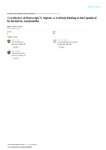Contribution of murine IgG Fc regions to antibody binding to the capsule of<i>Burkholderia pseudomallei</i>
| dc.contributor.author | Dillon, Michael | |
| dc.contributor.author | Loban, RA | |
| dc.contributor.author | Reed, DE | |
| dc.contributor.author | Thorkildson, P | |
| dc.contributor.author | Pflughoeft, KJ | |
| dc.contributor.author | Pandit, SG | |
| dc.contributor.author | Brett, PJ | |
| dc.contributor.author | Burtnick, MN | |
| dc.contributor.author | AuCoin, DP | |
| dc.date.accessioned | 2021-09-16T14:35:04Z | |
| dc.date.available | 2021-09-16T14:35:04Z | |
| dc.date.issued | 2016-08-17 | |
| dc.identifier.issn | 2150-5594 | |
| dc.identifier.issn | 2150-5608 | |
| dc.identifier.uri | http://hdl.handle.net/10026.1/17806 | |
| dc.description.abstract |
Immunoglobulin G3 (IgG3) is the predominant IgG subclass elicited in response to polysaccharide antigens in mice. This specific subclass has been shown to crosslink its fragment crystallizable (Fc) regions following binding to multivalent polysaccharides. Crosslinking leads to increased affinity through avidity, which theoretically should lead to more effective protection against bacteria and yeast displaying capsular polysaccharides on their surface. To investigate this further we have analyzed the binding characteristics of 2 IgG monoclonal antibody (mAb) subclass families that bind to the capsular polysaccharide (CPS) of Burkholderia pseudomallei. The first subclass family originated from an IgG3 hybridoma cell line (3C5); the second family was generated from an IgG1 cell line (2A5). When the Fc region of the 3C5 IgG3 is removed by proteolytic cleavage, the resulting F(ab')2 fragments exhibit decreased affinity compared to the full-length mAb. Similarly, when the parent IgG3 mAb is subclass-switched to IgG1, IgG2b, and IgG2a, all of these subclasses exhibit decreased affinity. This decrease in affinity is not seen when the 2A5 IgG1 mAb is switched to an IgG2b or IgG2a, strongly suggesting the drop in affinity is related to the IgG3 Fc region. | |
| dc.format.extent | 691-701 | |
| dc.format.medium | Print-Electronic | |
| dc.language | en | |
| dc.language.iso | eng | |
| dc.publisher | Informa UK Limited | |
| dc.subject | antibody | |
| dc.subject | binding affinity | |
| dc.subject | capsule | |
| dc.subject | melioidosis | |
| dc.subject | polysaccharide | |
| dc.title | Contribution of murine IgG Fc regions to antibody binding to the capsule of<i>Burkholderia pseudomallei</i> | |
| dc.type | journal-article | |
| dc.type | Journal Article | |
| dc.type | Research Support, N.I.H., Extramural | |
| plymouth.author-url | https://www.webofscience.com/api/gateway?GWVersion=2&SrcApp=PARTNER_APP&SrcAuth=LinksAMR&KeyUT=WOS:000382325700011&DestLinkType=FullRecord&DestApp=ALL_WOS&UsrCustomerID=11bb513d99f797142bcfeffcc58ea008 | |
| plymouth.issue | 6 | |
| plymouth.volume | 7 | |
| plymouth.publication-status | Published | |
| plymouth.journal | Virulence | |
| dc.identifier.doi | 10.1080/21505594.2016.1176655 | |
| plymouth.organisational-group | /Plymouth | |
| plymouth.organisational-group | /Plymouth/Faculty of Health | |
| plymouth.organisational-group | /Plymouth/Faculty of Health/Peninsula Medical School | |
| plymouth.organisational-group | /Plymouth/Users by role | |
| plymouth.organisational-group | /Plymouth/Users by role/Academics | |
| dc.publisher.place | United States | |
| dc.identifier.eissn | 2150-5608 | |
| dc.rights.embargoperiod | Not known | |
| rioxxterms.versionofrecord | 10.1080/21505594.2016.1176655 | |
| rioxxterms.licenseref.uri | http://www.rioxx.net/licenses/all-rights-reserved | |
| rioxxterms.type | Journal Article/Review |


